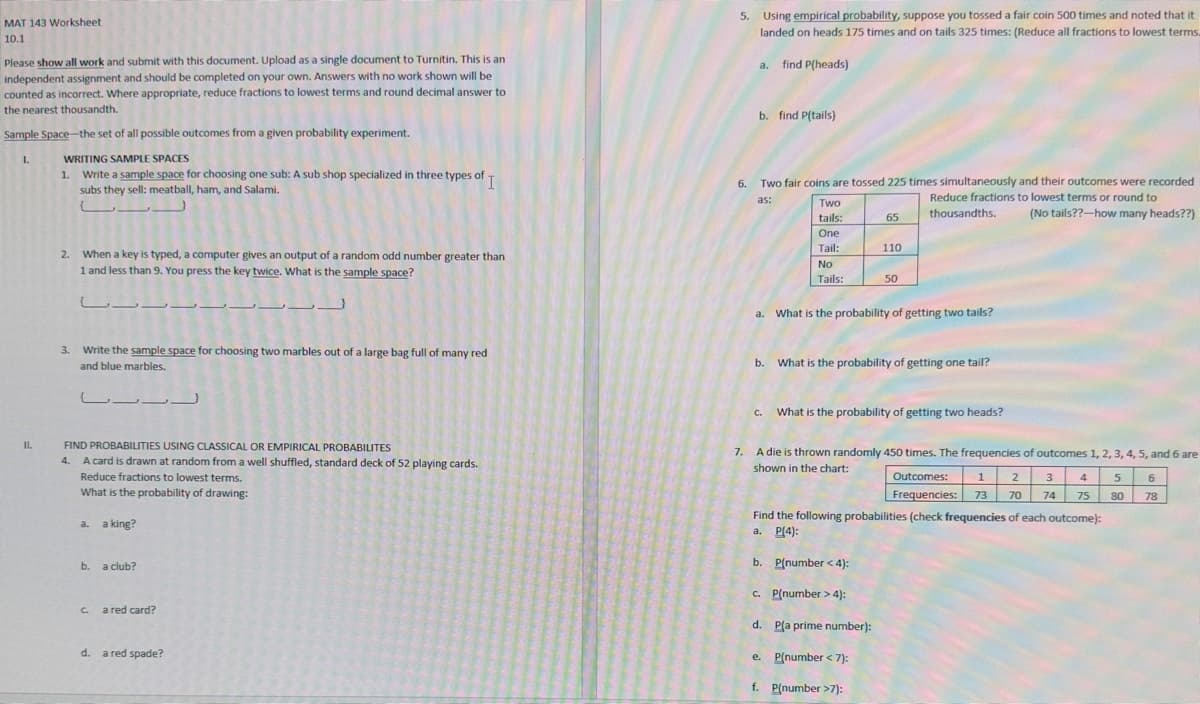5. Using empirical probability, suppose you tossed a fair coin 500 times and noted that it landed on heads 175 times and on tails 325 times: (Reduce all fractions to lowest terms. a. find P(heads) 6. b. find P(tails) Two fair coins are tossed 225 times simultaneously and their outcomes were recorded as: Reduce fractions to lowest terms or round to thousandths. Two tails: One Tail: No Tails: 65 110 50 a. What is the probability of getting two tails? b. What is the probability of getting one tail? c. What is the probability of getting two heads? 7. A die is thrown randomly 450 times. The frequencies of outcomes 1, 2, 3, 4, 5, and 6 are shown in the chart: Outcomes: 1 Frequencies: 72 (No tails??-how many heads??) 2 70 3 74 4 75 5 6 90 72
5. Using empirical probability, suppose you tossed a fair coin 500 times and noted that it landed on heads 175 times and on tails 325 times: (Reduce all fractions to lowest terms. a. find P(heads) 6. b. find P(tails) Two fair coins are tossed 225 times simultaneously and their outcomes were recorded as: Reduce fractions to lowest terms or round to thousandths. Two tails: One Tail: No Tails: 65 110 50 a. What is the probability of getting two tails? b. What is the probability of getting one tail? c. What is the probability of getting two heads? 7. A die is thrown randomly 450 times. The frequencies of outcomes 1, 2, 3, 4, 5, and 6 are shown in the chart: Outcomes: 1 Frequencies: 72 (No tails??-how many heads??) 2 70 3 74 4 75 5 6 90 72
Holt Mcdougal Larson Pre-algebra: Student Edition 2012
1st Edition
ISBN:9780547587776
Author:HOLT MCDOUGAL
Publisher:HOLT MCDOUGAL
Chapter6: Ratio, Proportion, And Probability
Section6.7: Probability And Odds
Problem 2C
Related questions
Question
I need help on II.4,5,6

Transcribed Image Text:MAT 143 Worksheet
10.1
Please show all work and submit with this document. Upload as a single document to Turnitin. This is an
independent assignment and should be completed on your own. Answers with no work shown will be
counted as incorrect. Where appropriate, reduce fractions to lowest terms and round decimal answer to
the nearest thousandth.
Sample Space-the set of all possible outcomes from a given probability experiment.
WRITING SAMPLE SPACES
1. Write a sample space for choosing one sub: A sub shop specialized in three types of
subs they sell: meatball, ham, and Salami.
L
I.
IL
2.
When a key is typed, a computer gives an output of a random odd number greater than
1 and less than 9. You press the key twice. What is the sample space?
3.
بیا
Write the sample space for choosing two marbles out of a large bag full of many red
and blue marbles.
بینا
FIND PROBABILITIES USING CLASSICAL OR EMPIRICAL PROBABILITES
4.
A card is drawn at random from a well shuffled, standard deck of 52 playing cards.
Reduce fractions to lowest terms.
What is the probability of drawing:
a. a king?
b. a club?
c. a red card?
d. a red spade?
5. Using empirical probability, suppose you tossed a fair coin 500 times and noted that it
landed on heads 175 times and on tails 325 times: (Reduce all fractions to lowest terms.
a. find P(heads)
b. find P(tails)
6. Two fair coins are tossed 225 times simultaneously and their outcomes were recorded
Reduce fractions to lowest terms or round to
thousandths. (No tails??-how many heads??)
as:
a.
Two
tails:
One
Tail:
No
Tails:
65
110
What is the probability of getting two tails?
50
b. What is the probability of getting one tail?
c. What is the probability of getting two heads?
e. P(number<7):
7.
A die is thrown randomly 450 times. The frequencies of outcomes 1, 2, 3, 4, 5, and 6 are
shown in the chart:
f. P(number >7):
1
2
4
Outcomes:
3
Frequencies: 73 70 74 75
Find the following probabilities (check frequencies of each outcome):
a. P(4):
b. P(number<4):
c. P(number > 4):
d. P(a prime number):
5
80
6
78
Expert Solution
This question has been solved!
Explore an expertly crafted, step-by-step solution for a thorough understanding of key concepts.
This is a popular solution!
Trending now
This is a popular solution!
Step by step
Solved in 4 steps

Recommended textbooks for you

Holt Mcdougal Larson Pre-algebra: Student Edition…
Algebra
ISBN:
9780547587776
Author:
HOLT MCDOUGAL
Publisher:
HOLT MCDOUGAL

Glencoe Algebra 1, Student Edition, 9780079039897…
Algebra
ISBN:
9780079039897
Author:
Carter
Publisher:
McGraw Hill

College Algebra (MindTap Course List)
Algebra
ISBN:
9781305652231
Author:
R. David Gustafson, Jeff Hughes
Publisher:
Cengage Learning

Holt Mcdougal Larson Pre-algebra: Student Edition…
Algebra
ISBN:
9780547587776
Author:
HOLT MCDOUGAL
Publisher:
HOLT MCDOUGAL

Glencoe Algebra 1, Student Edition, 9780079039897…
Algebra
ISBN:
9780079039897
Author:
Carter
Publisher:
McGraw Hill

College Algebra (MindTap Course List)
Algebra
ISBN:
9781305652231
Author:
R. David Gustafson, Jeff Hughes
Publisher:
Cengage Learning